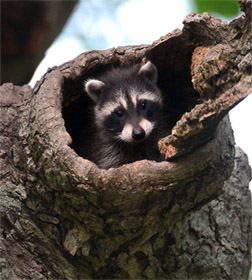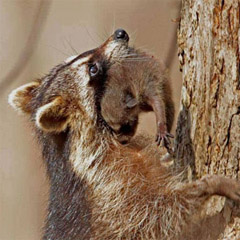 The raccoon (Procyon lotor) is a medium-sized mammal that is common throughout Indiana. Its black mask makes it easy to identify. Raccoons are found in both urban and rural areas and are a species that thrives around people. They are native only to North America.
The raccoon (Procyon lotor) is a medium-sized mammal that is common throughout Indiana. Its black mask makes it easy to identify. Raccoons are found in both urban and rural areas and are a species that thrives around people. They are native only to North America.
General characteristics
- Adults weigh 8-20 pounds, although weight can vary considerably based on food and habitat. Males are usually heavier than females.
- They have a distinct black mask around their eyes.
- Their bushy tail measures 8-16 inches long, with alternating rings of light and dark fur.
- Their coat is a mixture of grizzled gray, brown and black, but there can be large variations in color even among littermates.
- Raccoon ears are slightly rounded with white fur on the edges.
- Although not fast, they can reach speeds up to 15 mph.
- Raccoons are good climbers and climb down trees headfirst.
- Raccoons are usually nocturnal and usually spend daylight hours at rest. Contrary to common belief, a raccoon active during the day is not necessarily sick. Sometimes to beat other animals to good food sources (like chips around a park picnic table), raccoons will be active during daylight.
Distribution and abundance

Raccoons occur statewide. They are most numerous where a mix of woodlands, cropland and shallow water are found. Northeastern Indiana, with its glacial lakes, is where the raccoon population is the greatest. The farmland of central Indiana is also home to many raccoons. The heavily forested south-central hills and northwestern prairie regions are less attractive to raccoons, but they are still common in these areas.
Reproduction
Most mating occurs in January or February. The male assumes no part in raising young. Most raccoons are born in tree cavities. If tree dens are not readily available, a female may use abandoned barn lofts, rock outcroppings, ground burrows or even attics and chimneys as dens.
Litters are usually born in April or May and range in size from one to nine, although the average is four. By mid-June, most young raccoons accompany their mother on food searches and begin to learn survival skills.
Food habits
Raccoons are opportunists, eating both plants and animals. Some common food sources are:
- Frogs
- Crayfish
- Turtle and bird eggs
- Small mammals
- Fruits, vegetables and crops like corn
- Beechnuts and acorns
Raccoons have very sensitive paws, making their sense of touch one of their most important for finding food. If water is nearby, the raccoon will appear to “wash” its food; however, the animal is actually kneading and tearing at the food, feeling for matter that shouldn’t be eaten. Wetting its paws enhances the raccoon’s touch. If water is not nearby, the raccoon will forego this ritual. Sometimes raccoons will appear to be “washing” food when really they are hunting for crayfish or mussels along the shores of creeks and ponds by feel.
Viewing Tips
Raccoons are most active at night, so often the best chance for viewing them is on an evening stroll or drive near their sources of food. Gardens, small streams, trash cans, sweetcorn fields, dumpsters, and birdfeeders are all choice food spots a raccoon might visit once the sun goes down. Eye shine, which is the light that bounces off the reflective membrane in nocturnal animal eyes, can help with identification but also vary by individual animal, how far you are from the animal, and the light source. Raccoon eye shine is typically bright yellow.
Raccoons will also visit key food sources during the day if they are worried about other animals finding the best food before them. Picnic areas and campgrounds can be a chance to catch a glimpse of a raccoon, like at Fort Harrison State Park or Glendale Fish & Wildlife Area. Remember—seeing a raccoon out during the day doesn’t necessarily mean the raccoon is sick. Never approach or feed wildlife, even if they are looking for a snack.
Management and control
Raccoon populations were low in the early 1900s, but began to rebound in the mid-1900s. A few attempts at bringing raccoons in from other states to bolster populations were conducted into the 1970s, despite growing raccoon populations. Now, with raccoons readily adapting to urban living, populations are strong throughout the state.
Resident landowners and tenants can trap or shoot a raccoon that is causing damage on their own property without a permit from the DNR, but all local ordinances regarding firearm, archery, or air rifle discharge must be followed. The raccoon must be euthanized or released within the county of capture on private property in which you have permission to release the raccoon. In order to prevent the spread of disease, the DNR encourages homeowners to safely and humanely euthanize the raccoons, if possible. If you do not want to remove the raccoon yourself, you can hire a Wildlife Control Operator.
Living with raccoons
Raccoons can often cause problems for landowners. Here are some tips for preventing raccoons around your home or garden:
- For gardens, string a single strand of electric fence 8 inches above the ground around the perimeter of the garden.
- Placing a radio on a talk station and leaving it on overnight may discourage raccoons from approaching or denning under decks or porches.
- Keep bird feeders and garbage cans inside at night. Don’t leave pet food outside. Clean up fruit from around fruit trees and ensure compost is secure from raccoon access.
- Occasionally, raccoons may enter a house through a pet door. If you have a raccoon in the house, close all doors that provide access to other parts of the house. Open windows and doors to the outside so the animal can exit quietly on its own. Wait for the animal to leave, then close all openings, including the pet door, to prevent the raccoon from returning.
- Trim overhanging tree limbs to prevent easy access to your roof and attic.
- Ensure there are no access points to attics, chimneys, garages, or sheds as raccoons will readily make themselves at home in a warm, sheltered space.
